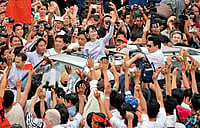While the government in New Delhi talks tough about pounding Pakistan across the border for its terrorist activities in Jammu and Kashmir, the people caught in the crossfire have a different message for Prime Minister Narendra Modi.
“By all means, give munh tod jawab (jaw-breaking reply) to Pakistan, but please do it from Delhi or Mumbai. Why should we pay the price?” asks Sukhdev Singh, sarpanch of Ganiah village on the Line of Control (LoC) in Nowshera.
There are 23 villages of the Nowshera subdivision of Rajouri district that are adjacent to the LoC. With a population of around 25,000, these villages live in constant fear of being hit by mortar shells and sniper fire—and, of late, by artillery shells.
From Ganiah village, just 1.5 km from the LoC, one can clearly see the Indian border post on a hilltop opposite. Mortar shells which miss the Indian army post hit the village, sending villagers rushing into the seven bunkers that the government has built for them.
“We mostly get mortar shells and 120mm artillery gun fire,” says Sukhdev Singh, who retired from the Indian Army. “We have seen so much firing that everyone knows the calibre of the shells. Adversity has made half-soldiers out of the farmers. But this cannot go on. While individual or community bunkers do provide some sense of security, they are not the solution,” he says.
The villagers see themselves as permanent collateral victims of India-Pakistan tensions, having faced bullets and mortar shells in every war with Pakistan. Since January this year, villages that have been affected by shelling include Pukharni, Sair Makri, Bhawani, Khamba, Kalal, Ganaih and Khori.
Between 2017 and 2018, cross-LoC firing has caused four civilian deaths, eight have been injured, 124 houses damaged, 189 cattle killed and 98 injured. Three school buildings, one panchayat building and one cattle shed have been destroyed. Numerous water tanks, transformers, electric poles and transmission lines have also been damaged. Since January 9, 71 schools within a five km distance of the LoC have been shut down.
The evacuees have formed a LoC Border Migrants Committee. Purshottam Lal, a representative of the committee from Khamba village, says, “For two years our people have been living in camps off and on. As a result, our children’s education and our financial condition have been affected. Small businesses like cattle-rearing or running a dairy are hurt when livestock is killed. People can’t repay the bank loans they have taken.”
Life is equally precarious on the international border (IB) in Jammu. In Bera village in Ranbirsinghpura sector, sarpanch Vijay Chib lost her brother-in-law to shell firing on January 20, when he went out to relieve himself. She says, “We should either talk to Pakistan or fight an aar-paar ki ladai (a decisive battle) to settle this issue. Why should we continue suffering like this?” There are about 50 unexploded mortar shells lying around Bera that the villagers dare not touch. The Bomb Disposal Squad of J&K police has not had the time to defuse them.
Jeora Farm, about 100 metres from the IB, has about 185 Muslim Gujjar families. It has also been a victim of intense shelling. Rashed Ali’s house caught fire after a mortar shell came through the roof. “Now we live in a camp at Chakroi at night and come back during the day to look after our animals. Between January 19 and 23, our village lost 200 cattle, including horses, buffaloes, goats and sheep; 24 thatched houses were destroyed and 27 damaged,” he laments.
Liaquat Ali, who lost 15 buffaloes to mortar shells on the night of January 20-21, says, “One buffalo can cost Rs. 1-1.5 lakh. But the compensation is only Rs 10,000 per animal and you get compensation for a maximum of three animals. Tell me if that’s fair.”
There are two community bunkers in Jeora Farm, housing around 100, but only six to seven villagers spend the night there. The rest go to a makeshift camp, returning only at daybreak.
The same routine is followed by villagers in Kapurpur, also on the IB. A 17-year-old boy, Gara Ram, was killed by a mortar shell on January 20 here. His uncle, Thodu Ram, says, “Our Gara was the only son of the family and worked in a barber shop in RS Pura. His sister is getting married in March, but he won’t be able to see that.... Now his sister may get a government job under the Special Rehabilitation Order (SRO). But who will give us back our son?”
Whether along the LoC or the IB, villagers demand the same thing—resettlement to a safer location. Owners of fertile land, they only want land for houses at a safe distance so that they can still work on their fields. They also want the government to build more bunkers, both for individual families as well as larger community ones. Already, 49,018 bunkers have been sanctioned for Rajouri district, of which 374 will be community bunkers. People also want quick payment of compensation for cattle deaths, damage to standing crops, special quotas in government jobs, the army and the paramilitary forces, and ‘grace-marks’ for students whose schooling has been disturbed.
The situation is most critical in those villages of Uri where the border fence erected by India is one to two kilometres inside the LoC. It leaves Indian villages like Churanda, Hathlanga and Saura beyond the border fence, and others like Sillikot and Tillawadi straddling it. In Churanda, barely 20 metres from the LoC, people can shout out to their relatives in the Pakistani village of Khwaja Banday. To go to work in Uri or to take their cattle for grazing, they are allowed to cross the fence through a gate open only from 9 am to 5 pm.

A boy holds the tail unit of a mortar shell in front of his damaged house in Nowshera
There are army posts between the fence and the LoC alongside these settlements in Uri. When these posts are targeted by the Pakistan army, collateral deaths and injuries among villagers are often the result. About 1,500 people from these villages were evacuated after intense exchange of fire began on February 20, which finally escalated to the use of field artillery—a line not crossed in Uri in the last 15 years.
Mohammad Lateef from Churanda says, “My family has been evacuated thrice—in 1992, 1997 and now in 2018. One woman was injured this time and about 30-35 houses were damaged.”
Reports that the Pakistani Army had addressed Indian villagers and asked them to evacuate are misrepresented, says Lateef. “There were two announcements from the mosque at Khwaja Banday village on the Pakistan side, one on February 20 and another on February 24. The first requested both sides to stop firing so that an eight-year-old boy could be buried. The firing stopped for three hours. On the 24th again it asked for firing to stop as there were some casualties in the village. This time the announcement also urged villagers to evacuate, but this was addressed to people on their own side.”
In Sillikot, the house of Fayyaz Ahmad was completely destroyed in the shelling. “Luckily, the gate on the border fence was open and we could flee. About 22 houses have been damaged by mortar shells,” he recalls.
Another villager, Abdul Qayoom, wonders how he will repay his housing loan of Rs 9 lakh, now that it has been damaged. “I have 12 family members. Where will we go now and how will I repay the bank?” he wonders, before breaking down. Visibly embarrassed and unable to control his sobbing, he cries, “Ladkiyan jawan ho gayi hain. Shaadi ke layaq hain. Jayen to jayen kahan (My daughters have come of age. I should be getting them married. But what should I do)?”
The litany of woes continues. Hanifa, in her late forties, first lost her young daughter to shelling in 2001; then her husband was hit fatally in 2003. Helpless, she continued in Sillikot. “We have had to leave because of the shelling again. Where should I go with my young children?” she asks, wiping her tears.
As of now, the state government has no plan to resettle villagers who live beyond the fence in Uri. The army prefers villages on the LoC that are settled, as they need villagers to work as porters, masons and casual workers. The district administration does not know how to deal with the demand for relocation but assures people that their demand will be forwarded to the government after a survey. “We have to say this or the situation will get politicised. I hope they agree to go back to their villages soon,” says a district official.
Overlying the misery is a sense of hopelessness. No one either in Jammu or in the Kashmir Valley believes that the Centre will defuse border tensions. Continual suffering and offers of bunkers and periodic evacuation are their lot, believe villagers.
Asharaf Mir, a businessman from Srinagar, says, “We had expected the Narendra Modi government to further the legacy of Atal Behari Vajpayee. He should ask himself—have we progressed since Vajpayee’s time in Kashmir or regressed? If he thinks that spending Rs 5 to 7 crore a day on border firing is good for the nation, then he should explain to us how.”
Haji Mohammad Yasin Khan, chairman of the Kashmir Economic Alliance, explains the border tension, saying, “This benefits the BJP. They have a constituency which thinks that Modi is doing the right thing—banning beef, removing Haj subsidies and teaching Pakistan a lesson. The shallow people who run the BJP don’t realise that they are ruining the country.”
A Kashmir intellectual echoes a similar sentiment: “Because of its inability to deal with terrorism, the ruling dispensation is heating up the border. Nothing that Modi had promised to the people has been delivered and his advisors want him to follow a doctrine of tit-for-tat with Pakistan, ruling out dialogue. With about a year left for the next general election, it suits him to escalate tensions. What else can he offer to his radical Hindutva constituency?”
(The writer is a journalist based in Delhi)


























